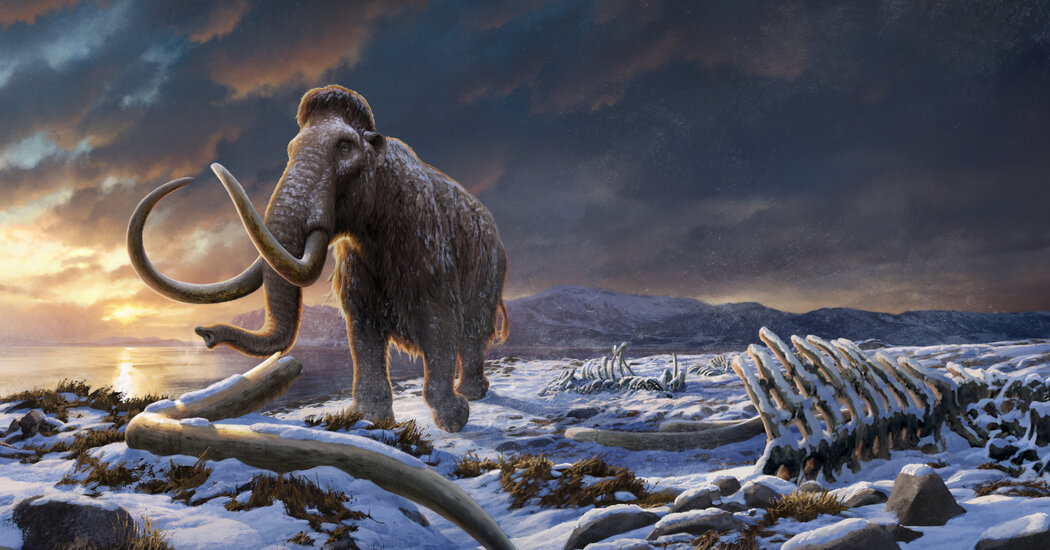For millions of years, mammoths lumbered across Europe, Asia and North America. Starting roughly 15,000 years ago, the giant animals began to vanish from their vast range until they survived on only a few islands.
Eventually they disappeared from those refuges, too, with one exception: Wrangel Island, a land mass the size of Delaware over 80 miles north of the coast of Siberia. There, mammoths held on for thousands of years — they were still alive when the Great Pyramids were built in Egypt.
When the Wrangel Island mammoths disappeared 4,000 years ago, mammoths became extinct for good.
For two decades, Love Dalén, a geneticist at Stockholm University, and his colleagues have been extracting bits of DNA from fossils on Wrangel Island. In recent years, they have gathered entire mammoth genomes. On Thursday, they published a reconstruction of the genetic history of these enigmatic animals.
The scientists concluded that the island’s population was founded about 10,000 years ago by a tiny herd made up of fewer than 10 animals. The colony survived for 6,000 years, but the mammoths suffered from a host of genetic disorders.
Oliver Ryder, the director of conservation genetics at San Diego Zoo Wildlife Alliance, said that the study held important lessons for trying to save species from extinction today. It shows that inbreeding could cause long-term harm.
“The mammoth study allows one to examine that process over thousands of years,” said Dr. Ryder, who was not involved in the new study. “We don’t have data like that for the species we are trying to save now.”
Dr. Dalén and his colleagues examined the genomes of 14 mammoths that lived on Wrangel Island from 9,210 years to 4,333 years ago. The researchers compared the DNA from the Wrangel Island mammoths with seven genomes from mammoths that lived on the Siberian mainland up to 12,158 years ago.
The genome of any animal contains a tremendous amount of information about the population it belonged to. In big populations, there is a lot of genetic diversity. As a result, an animal will inherit different versions of many of its genes from its parents. In a small population, animals will become inbred, inheriting identical copies of many genes.
The oldest Wrangel Island fossils contain identical versions of many genes. Dr. Dalen and his colleagues concluded that the island was founded by a remarkably tiny population of mammoths.
Before about 10,000 years ago, Wrangel Island was a mountainous region on the mainland of Siberia. Few mammoths spent time there, preferring lower regions where more abundant plants grew.
But at the end of the ice age, melting glaciers submerged the northern margin of Siberia. “There was one small herd of mammoths that happened to be on Wrangel Island when it was cut off from the mainland,” Dr. Dalén said.
The mammoths on the mainland faced significant challenges to their survival. Humans hunted them down, while the changing climate wiped out much of their grassland habitat, turning it to tundra.
But the few mammoths stranded on Wrangel Island enjoyed a tremendous stroke of good luck. The island was free of people and other predators, and they faced no competition from other grazing mammals. What’s more, the climate on Wrangel Island turned it into an ecological time capsule, where the mammoths could still enjoy a diversity of ice age plants.
“Wrangel Island was a golden place to live,” Dr. Dalén said.
He and his colleagues found that the population on Wrangel Island expanded from fewer than 10 mammoths to about 200. That was probably the maximum number of mammoths the island’s plant life could support.
But life was far from perfect for the Wrangel mammoths. The few animals that founded the island had very little genetic diversity, and Dr. Dalén and his colleagues found that the level stayed low for the next 6,000 years.
“They carried with them the inbreeding that they got in the early days,” he said.
As a result, the mammoths probably suffered a high level of inherited diseases. Dr. Dalén suspects that these sick mammoths managed to survive for hundreds of generations because they had no predators or competitors. The Wrangel Island herd would probably have quickly disappeared on the mainland.
The new study doesn’t reveal how exactly the Wrangel mammoths met their end. There’s no evidence that humans are to blame; the earliest known visitors to Wrangel Island appear to have set up a summer hunting camp 400 years after the mammoths became extinct.
For now, Dr. Dalén can only speculate about the true cause of the mammoth extinction. The war in Ukraine has made it impossible for him and his colleagues to travel to Russia to do further research.
It’s possible that a tundra fire killed off the Wrangel mammoths, or that the eruption of an Arctic volcano may have done them in. Dr. Dalén can even imagine that a migratory bird brought an influenza virus to Wrangel Island, which then jumped to the mammoths and wiped them out.
“We’re still left with a number of possible explanations, and we still haven’t been able to narrow it down,” he said.
Dr. Dalén thinks the new study bodes ill for conservation biologists who are trying to rescue species that have come close to extinction. Even if they restore a species to a bigger population, it may remain burdened with a low level of genetic diversity.
Dr. Dalén said that it may be essential to boost the genetic diversity of recovering populations. Conservation biologists have been investigating how to do this — moving individual animals between populations so they can interbreed, for example.
Cloning might provide another way to help species recovery. Dr. Ryder and his colleagues have been freezing cells from endangered animals to preserve some of their genetic diversity. In 2021, researchers succeeded in producing a clone of a black-footed ferret from a population that had become extinct in the 1980s.
Without these interventions, an endangered species may struggle to escape a legacy of inbreeding, even after hundreds of generations. “It may still have these time bombs in its genome that don’t bode well for the long term,” Dr. Ryder said.







